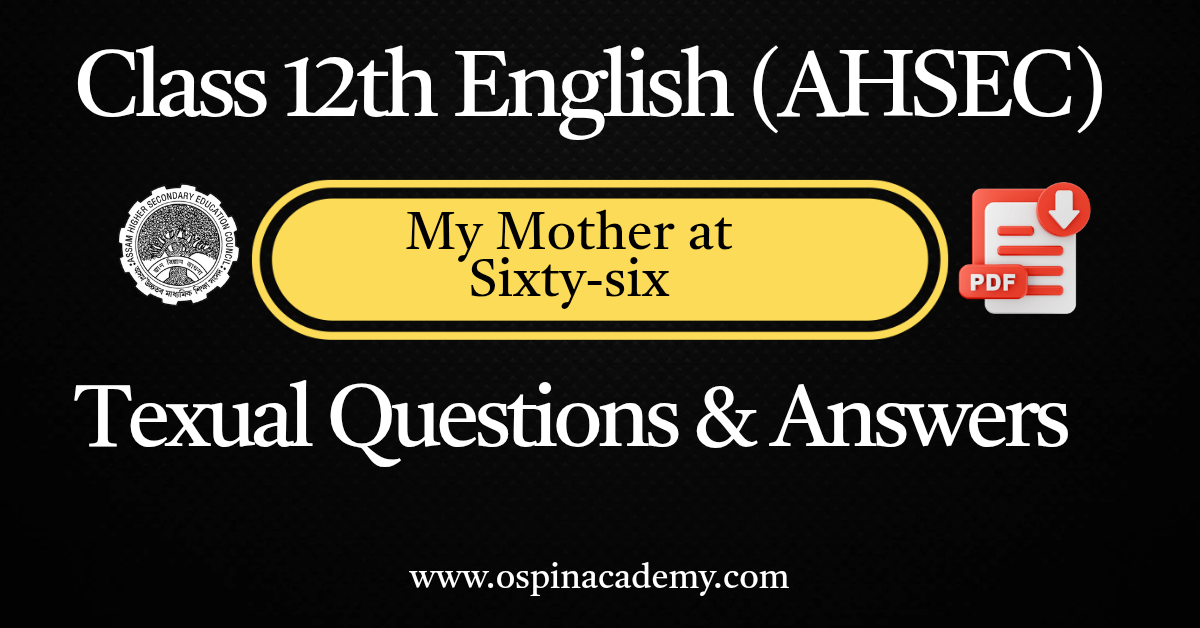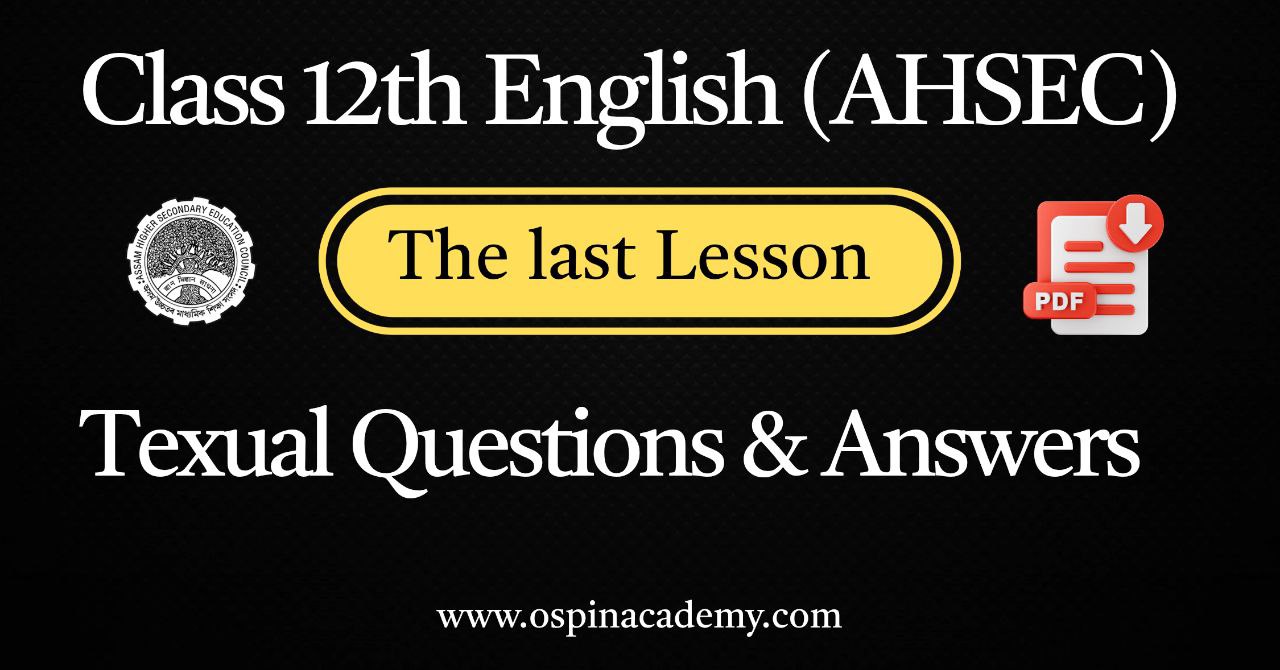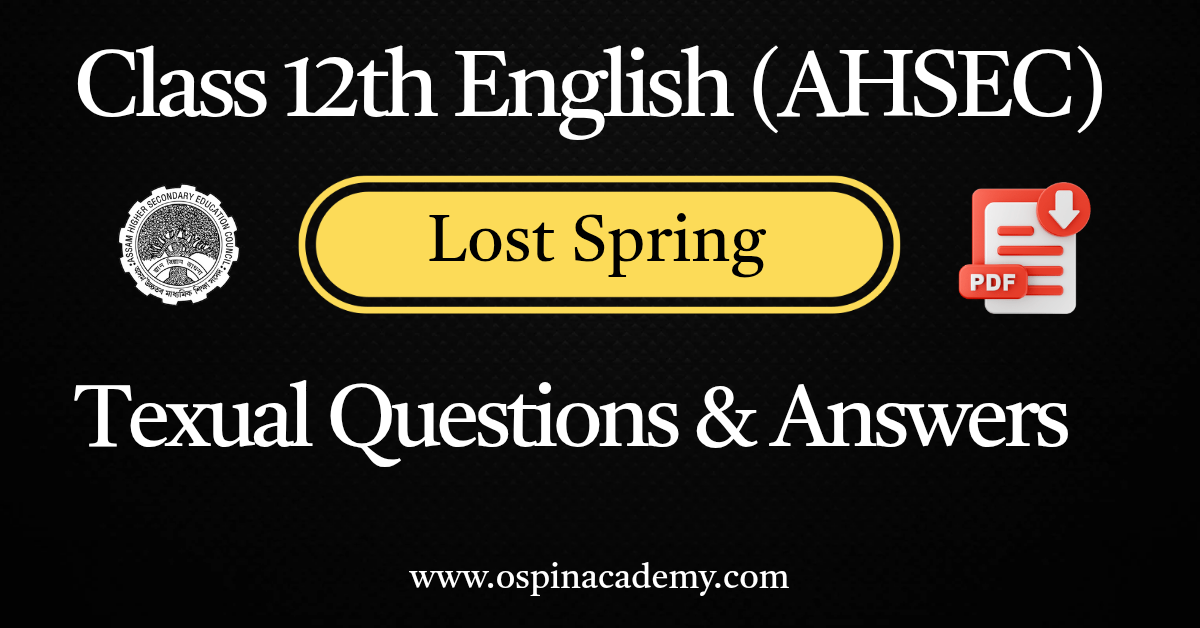Class 12 English Chapter 10 – My Mother at Sixty-six Solutions | AHSEC (English Medium)
Class 12 English Chapter 10 – My Mother at Sixty-six (AHSEC – English Medium) Complete Solutions and Notes
“My Mother at Sixty-six” is a poignant poem by Kamala Das included in the AHSEC Class 12 English textbook. The poem explores emotions of love, aging, and concern for the poet’s mother. Ospin Academy delivers detailed explanations, question-answer sets, and notes aligned with AHSEC syllabus to help students prepare effectively for their board exams.
✅ What You Will Learn:
- Summary and thematic analysis of “My Mother at Sixty-six”
- Understanding of imagery and emotions in the poem
- Questions and answers based on AHSEC board exam format
- Interpretation of metaphors and poetic devices used
- Value-based questions for comprehensive exam study
🎯 Ospin Academy Benefits:
- Solutions carefully crafted as per AHSEC syllabus
- Easy-to-understand language and explanations
- Exam-focused questions and answers for higher scoring
- Downloadable study notes and PDFs available
- Expert tips to excel in AHSEC board English exams
📘 Quick Reference:
- Textbook: Flamingo (Poetry)
- Chapter: 10 – My Mother at Sixty-six
- Author: Kamala Das
- Board: AHSEC (Assam Higher Secondary Education Council)
Class 12 English | Chapter-wise Solutions & Notes PDF (Assam Board)
Limited Time Offer!
(For AHSEC Class 12, 2025 Syllabus)
Ace your AHSEC Class 12 English exam preparation with this complete chapter-wise solutions & notes PDF.
Includes summaries, meanings, question answers, analysis, and important exam notes for all prose and poems.
Perfect for board exam readiness and concept clarity!
Poem – Chapter 1
My Mother at Sixty-six
Before you read : Solutions of Questions on Page Number : 90
Question:
Ageing is a natural process; have you ever thought what our elderly parents expect from us?
Answer : Aged people usually undergo pangs of loneliness and need companionship. The pessimistic approach they develop towards life can be shunned only if we provide them with abundant love, care, importance and empathy. They expect their children to sit calmly and talk to them about the happenings of their lives and to take their suggestions for making significant decisions. Their lost vitality can thus be easily rejuvenated. This happiness will encourage them to live life
enthusiastically.
(A model answer has been provided for students’ reference. It is strongly recommended that students prepare the answer on their own.)
Think it out : Solutions of Questions on Page Number : 91
Question:
What is the kind of pain and ache that the poet feels?
।Answer :
The poet, while leaving her parent’s home, observes her mother’s pallid face. For the poet, the ‘ashen’ face of her mother, lost of all vitality and colour, bears resemblance
to a corpse. She realises, with pain, that her mother has grown old and is nearing her death. Such thoughts make her recollect her childhood fear and anxiety of losing her mother. The idea of getting separated from her mother distresses her. Even her smiles are an expression of her helplessness at the face of what is inevitable.
Question:
Why are the young trees described as ‘sprinting’?
Answer :
While driving to the airport, in an effort to distract herself from the thoughts of her ageing mother, the poet looks at the young trees ‘sprinting’. The trees seem to be running past the moving car. The sprinting of the trees symbolises the rapidly passing years of human’s life from childhood to old age. This image, which shows activity and strength, is contrasted with that of her old and weak mother who seems dormant, sleeping in the car. The ‘young’ trees
represent life in contrast to her mother’s approaching death.
Question:
Why has the poet brought in the image of the merry children ‘spilling out of their homes’?
Answer :
In the poem, the poet has shown contrasting images of life and death. She has incorporated the image of the merry children, running out of their houses to play, in order to signify liveliness, vigor, health, beauty and happiness. This image is a sharp contrast to that of her mother who is nearing her death and has become old, inactive, weak and withered. The poet has juxtaposed the two images to indicate the contrasts between them. Childhood marks the beginning of life whereas old age marks its end.
Question:
Why has the mother been compared to the ‘late winter’s moon’?
Answer :
With the growing age, the poet’s mother has started losing all her vitality and radiance. The poet uses the simile of ‘late winter’s moon’ for her mother to indicate her approaching death. Winter, being the last season of the
year, is synonymous with lifelessness and dormancy. And, a winter’s moon is also pale-white in colour bearing close resemblance with her mother who, having lost all her strength and beauty, looks ‘wan’ and ‘pale’ to the poet. Her mother, too, is in the last phase of her life.
Question:
What do the parting words of the poet and her smile signify?
Answer :
The poet’s parting words, “see you soon, Amma,” signify both her farewell to her mother and an effort to leave her with optimism and cheer. They also enable the poet to empathise with the sense of isolation faced by her mother in the old age.
Her smiles signify her helplessness at the face of her mother’s inevitable death. They express her love and concern for her mother along with the underlying pain and struggle that she undergoes in coming to terms with this bitter realisation.
Frequently Asked Questions – My Mother at Sixty-six (AHSEC Class 12 English)
Get Free NCERT PDFs
If you want to download free PDFs of any chapter, click the link below and join our WhatsApp group:




